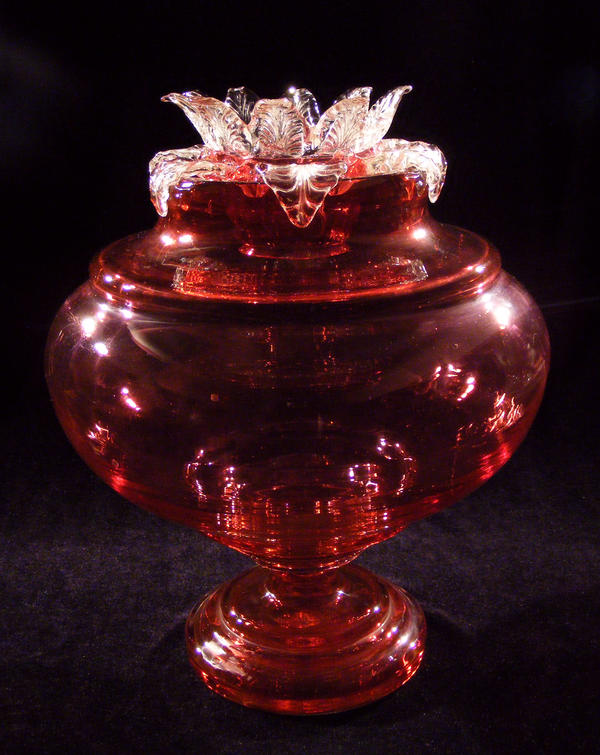A kerosene lamp is a type of lighting device that uses kerosene as fuel. Such lamps were used in households between the mid-19th and the early 20th century. Fuel tanks were made of metal, porcelain, and glass.
This fuel tank was produced at the Dyatkovo Crystal Factory. It was made using the free blowing technique where the glass is produced and decorated immediately at the glass melting furnace. The Russian term for this technique “gutnaya” most likely originated from the Latin word “gutta” meaning “a drop”. In this case, it is a drop of hot glass mass. The glass is blown at a temperature of around 900 ºС.
The main part of the item is made of pink glass, and the top is made of colorless crystal. The pink color is obtained by adding gold compounds to the mixture for making glass. Red glass of various shades, from scarlet to purple is known as “ruby glass” or simply “rubies”. Depending on the heating conditions, glass painted with gold can take on such shades as pink, purple, and sometimes even blue. The Dyatkovo Crystal Factory mastered the process of making the “gold ruby” glass in the first half of the 19th century and produced such items for over a century.
The “gold ruby” is one of the most beautiful and expensive types of art glass, which is why “gold ruby” products were also expensive. Only a wealthy buyer could afford such a kerosene lamp in the 19th century. Kerosene lamps were not included in the price lists of the Dyatkovo Factory and were only made to order. However, the range of products was uniquely diverse. The factory specialized in producing highly artistic assorted glassware, including glasses, pitchers, bowls, decanters, and many other products. It also manufactured crystal fly traps, piano floor protectors, knife rests, candlesticks, fishbowls, power line insulators, and other unconventional items. Nowadays, many of these items have become obsolete and useless, including kerosene lamps which have rarely been used since electric light became widespread.
This fuel tank was produced at the Dyatkovo Crystal Factory. It was made using the free blowing technique where the glass is produced and decorated immediately at the glass melting furnace. The Russian term for this technique “gutnaya” most likely originated from the Latin word “gutta” meaning “a drop”. In this case, it is a drop of hot glass mass. The glass is blown at a temperature of around 900 ºС.
The main part of the item is made of pink glass, and the top is made of colorless crystal. The pink color is obtained by adding gold compounds to the mixture for making glass. Red glass of various shades, from scarlet to purple is known as “ruby glass” or simply “rubies”. Depending on the heating conditions, glass painted with gold can take on such shades as pink, purple, and sometimes even blue. The Dyatkovo Crystal Factory mastered the process of making the “gold ruby” glass in the first half of the 19th century and produced such items for over a century.
The “gold ruby” is one of the most beautiful and expensive types of art glass, which is why “gold ruby” products were also expensive. Only a wealthy buyer could afford such a kerosene lamp in the 19th century. Kerosene lamps were not included in the price lists of the Dyatkovo Factory and were only made to order. However, the range of products was uniquely diverse. The factory specialized in producing highly artistic assorted glassware, including glasses, pitchers, bowls, decanters, and many other products. It also manufactured crystal fly traps, piano floor protectors, knife rests, candlesticks, fishbowls, power line insulators, and other unconventional items. Nowadays, many of these items have become obsolete and useless, including kerosene lamps which have rarely been used since electric light became widespread.




